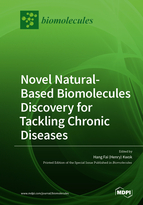Novel Natural-based Biomolecules Discovery for Tackling Chronic Diseases
A special issue of Biomolecules (ISSN 2218-273X). This special issue belongs to the section "Natural and Bio-inspired Molecules".
Deadline for manuscript submissions: closed (30 June 2020) | Viewed by 44799
Special Issue Editor
Interests: protease biochemistry; toxins; anti-cancer drug discovery; antibody therapy; venom-based peptides; prognostic and diagnostic biomarkers; proteomics
Special Issues, Collections and Topics in MDPI journals
Special Issue Information
Dear Colleagues,
Natural-based biomolecules continuously play an important role in novel drug discovery for treatment of chronic diseases. The development of natural peptide/protein-based, toxin-based, and antibody-based drugs can significantly improve the biomedical efficiency of disease-specific therapy.
The focus of this Special Issue of Biomolecules will be on the most recent advances related to novel peptides/proteins, antibodies, and toxins as forms of medicinal therapy. Recent advances in the discovery and development of these natural biomolecules as targeted therapy and immunotherapy for tackling chronic diseases (e.g., cancer, diabetes, cardiovascular diseases, and rheumatoid arthritis) will be addressed. The discussion on using novel disease-specific proteins/peptides/toxins/antibodies along with currently available FDA-approved drugs as combinatorial treatments will also be encouraged in this context. Finally, an overview of some selected promising natural biomolecules that are potentially able to address the forthcoming challenges in this field will be included. Both research (in particular) and review articles proposing novelties or overviews, respectively, are welcome.
Prof. Dr. Hang Fai (Henry) KwokGuest Editor
Manuscript Submission Information
Manuscripts should be submitted online at www.mdpi.com by registering and logging in to this website. Once you are registered, click here to go to the submission form. Manuscripts can be submitted until the deadline. All submissions that pass pre-check are peer-reviewed. Accepted papers will be published continuously in the journal (as soon as accepted) and will be listed together on the special issue website. Research articles, review articles as well as short communications are invited. For planned papers, a title and short abstract (about 100 words) can be sent to the Editorial Office for announcement on this website.
Submitted manuscripts should not have been published previously, nor be under consideration for publication elsewhere (except conference proceedings papers). All manuscripts are thoroughly refereed through a single-blind peer-review process. A guide for authors and other relevant information for submission of manuscripts is available on the Instructions for Authors page. Biomolecules is an international peer-reviewed open access monthly journal published by MDPI.
Please visit the Instructions for Authors page before submitting a manuscript. The Article Processing Charge (APC) for publication in this open access journal is 2700 CHF (Swiss Francs). Submitted papers should be well formatted and use good English. Authors may use MDPI's English editing service prior to publication or during author revisions.
Keywords
- antibody therapy
- peptide/protein drug
- natural toxins
- targeted therapy/immunotherapy for combinatorial treatment
- cancer
- diabetes
- heart disease
- inflammation







